Submitted:
20 January 2023
Posted:
24 January 2023
You are already at the latest version
Abstract
Keywords:
1. Introduction
2. Fly Ash Physical and Chemical Composition
3. Fly Ash Pozzolanic Activity

4. Fly Ash Engineering Properties
5. Impact of Fly Ash on Concrete Mechanical Properties
6. Fly Ash Applications in Concrete Construction Industry
7. Current Studies for Fly Ash Applications
8. Conclusions
9. Recommendations for Future Research
References
- Metals and Minerals Report. Fly ash market size, by type, application. Report ID:FBI101087, 2020.
- Prakash, R., Raman, S.N., Subramanian, C., and Divyah, N. Eco-friendly fiber-reinforced concretes. Handbook of Sustainable Concrete and Industrial Waster Management, 2022, pp. 109-145. [CrossRef]
- Prakash, R., Divyah, N., Srividhya, S., Avudaiappan, S., Amran, M., Raman, S.N., Guindos, P., Vatin, N.I., and Fediuk,R. Effect of steel fiber on the strength and flexural characteristics of coconut shell concrete partially blended with fly ash. MDPI Materials Journal, Vol. 15, No. 12, 2022. [CrossRef]
- Prakash, R., Thenmozhi, R., Raman, S.N., Subramanian, C., and Divyah, N. An investigation of key mechanical and durability properties of coconut shell concrete with partial replacement of fly ash, Structural Concrete. Vol. 22, 2020. [CrossRef]
- Gollakota, A.R.J., Volli, V., Shu, C.M. Progressive utilization prospects of coal fly ash: a review. Science of Total Environment Journal, Vol. 672, No. 1, 2019 pp. 951-989. [CrossRef]
- Kolias, S., Rigopoulou, V.K., Karahalios, A. Stabilization of clayey soils with high calcium fly ash and cement. Journal of Cement and Concrete Composites, Vol. 27, No. 2, 2005, pp. 301-313. [CrossRef]
- Chindaprasirt, P., Chareerat, T., and Sirivivatnanon, V. Workability and strength of coarse high calcium fly ash geopolymer. Journal of Cement and Concrete Composites, Vol. 29, No. 3, 2007, pp. 224-229. [CrossRef]
- Wang, S., Wu, H., Environmental-benign utilization of fly ash as a low-cost adsorbent. Journal of Hazardous Materials, Vol. 136, No. 3, 2006, pp. 482-501. [CrossRef]
- Nhan, C.T., Graydon, J.W., Kirk, D.W. Utilizing coal fly ash as a landfill barrier material. Journal of Waste Management, Vol. 16, No. 7, 1996, pp. 587-595. [CrossRef]
- Cokca, E., Yilmaz, Z. Use of rubber and bentonite added fly ash as a liner material. Journal of Waste Management, Vol. 24, No. 2, 2004, pp. 153-164. [CrossRef]
- Akhnoukh, A.K. The use of micro- and nano-sized particles in increasing concrete durability. Particulate Science and Technology, Vol. 38, No. 5, 2019, pp. 529-534. [CrossRef]
- Takada, T., Hashimoto, I., Tsutsumi, K., Shibata, Y., Yamamuro, S., Kamada, T., Inoue, K., Tsuzura, K., Yoshida, K., Utilization of coal ash from fluidized-bed combustion boilers as road base material. Journal of Resources, Conservation, and Recycling, Vol. 14, No. 2, 1995, pp. 69-77. [CrossRef]
- Prashanth, J.P., Sivapullaiah, P.V., and Sridharan, A. Pozzolanic fly ash as hydraulic barrier in land fills. Journal of Engineering Geology, Vol. 60, No. 1-4, 2001, pp. 245-252. [CrossRef]
- Akhnoukh, A.K. Development of high perfromance precast/prestressed bridge girders. Dissertation, University of Nebraska-Lincoln, Nebraska, USA, 2008.
- Akhnoukh, A.K., Soares, R. Reactive powder concrete application in the construction industry in the United States. Proceedings of the 10th Conference of Construction in the 21st Century, Srilanka, 2019.
- ASTM International. Standard specification for coal fly ash and raw calcined natural pozzolan for use in concrete. ASTM C618-19, 2019. [CrossRef]
- American Association of State Highway and Transportation Officials. Standard specification for coal fly ash and raw or calcined natural pozzolan for use in concrete. AASHTO M 295, 2021.
- Pandian, N.S., Rajasekhar, C., Sridharan, A. Studies of the specific gravity of come Indian coal ashes. Journal of Testing and Evaluation, Vol. 26, No. 3, 1998 pp. 177-186.
- ASTM International. Standard test method for sampling and testing fly ash or natural pozzolans for use in portland-cement concrete. ASTM C311/C311M-22, 2022. [CrossRef]
- ASTM International. Standard terminology relating to concrete and concrete aggregates. ASTM C125-13a, 2013.
- Rahhal, V., and Talero, R. Influence of two different fly ashes on the hydration of portland cements. Journal of Thermal Analysis and Calorimetry. Vol. 78, 2004, pp. 191-205. [CrossRef]
- Mostafa, N.Y., and Brown, P.W. Heat of hydration of high reactive pozzolans in blended cements: isothermal conduction calorimetry. Thermochimica Acta, Vol. 435, No. 2, 2005, pp. 162-167. [CrossRef]
- Akhnoukh, A.K. Overview of concrete durability evaluation using electrical resistivity. In: Ahmed, S.M., Hampton, P., Azhar, S., Saul, A. (eds) Collaboration and Integration in Construction, Engineering, Management and Technology. Advances in Science, Technology & Innovation. Springer, Cham. [CrossRef]
- McCarter, W.J., and Tran, D. Monitoring pozzolanic activity by direct activation with calcium hydroxide. Construction and Building Materials. Volume 10, No. 3, 1996, pp. 179-184. [CrossRef]
- Frias, M., Villar-Cocina, E., and Valencia-Morales, E. Characterization of sugar cane straw waste as pozzolanic material for construction: calcining temperature and kinetic parameters. Waste Management, Vol. 27, No. 4, 2007 pp. 533-538. [CrossRef]
- Ustabas, I., Erdogdu, S., Omur, I., and Yilmaz, E. Pozzolanic effect on the hydration heat of cements incorporating fly ash, obsidian, and slag additives. Engineering Design and Analysis of Sustainable Mine Fills, Vol. 2021, 2021. [CrossRef]
- Akhnoukh, A.K. Application of supplementary cementitious materials in precast concrete industry. Sustainability of Concrete with Synthetic and Recycled Aggregates (ed. H Saleh), 2021. [CrossRef]
- Kramar, S., and Ducman, V. Evaluation of ash pozzolanic activity by means of the strength activity index test, Frattini test and DTA/TG analysis. Technical Gazette, Vol. 25, No. 6, 2018 pp. 1746-1752. [CrossRef]
- Ahmaruzzaman, M. A review of the utilization of fly ash. Progress in Energy and Combustion Science, Vol. 36, No. 3, 2010, pp. 327-363. [CrossRef]
- Thakur, R.N., and Ghosh, S. Effect of mix composition on compressive strength and microstructure of fly ash based geopolymer composites. ARPN Journal of Engineering and Applied Science, Vol. 4, No. 4, 2009.
- Van Jaarsveld, J.G.S., Van Deventer, J.S.J., and Luckey, G.C. The characterization of source materials in fly ash-based geopolymers. Meterials Letters, Vol. 57, No. 7, 2003, 1272-1280. [CrossRef]
- Hanjitsuwan, S., Chindaprasirt, P., Pimraksa, K. Electrical conductivity and dielectric property of fly ash geopolymer paste. International Journal of Minerals, Mettallurgy, and Materials. Vol. 18, 2011, 94-99. [CrossRef]
- Esparham, A., Moradikhou, A.B., Avanaki, M.J. Effect of various alkaline activator solutions on compressive strength of fly ash based geopolymer concrete. Journal of Civil Engineering and Material Application, Vol. 4, No. 2, 2020, pp. 115-123. [CrossRef]
- Nagaraj, V.K., and Babu, D.L.V. Assessing the performance of molarity and alkaline activator ratio on engineering properties of self-compacting activated concrete at ambient temperature. Journal of Building Engineering. Volume 20, 2018, pp. 137-155. [CrossRef]
- Shilar, F.A., Ganachari, S.V., Patil, V.B., Khan, T.M.Y., Javed, S., and Baig, R.U. Optimization of alkaline activator on the strength of geopolymer concrete. Polymers, Vol. 14, No. 12, 2022. [CrossRef]
- Lim, N.H., Samadi, M., Ariffin, N.F., Hussin, M.W., Bhutta, M.A.R., Sarbini, N.N., Khalind, N.H.A, and Aminuddin, E. Effect of curing conditions on compressive strength of FA-POFA-based geopolymer mortar, IOP Conference Series: Materials Science and Engineering, Vol. 431, No. 9, 2018. [CrossRef]
- Kong, L., Fan, Z., Ma, W., Lu, J., and Liu, Y. Effect of curing conditions on the strength development of alkali-activated mortar. Crystals, Vol. 11, No. 12 2021. [CrossRef]
- Federal highway Administration. User guidelines for waste and byproduct materials in pavement construction. FHWA Publication No. FHWA-RD-97-148, 1997.
- ASTM International. Standard test method for fineness of hydraulic cement by air permeability apparatus. ASTM C204-18, 2018.
- Folliard, K., Hover, K., Harris, N., Ley, M.T., Naranjo, A. Effects of Texas fly ash on air-entrainment in concrete: comprehensive report. FHWA Report No. FHWA/TX-08/0-5207-1, 2009. [CrossRef]
- Akhnoukh, A., Ekhande, T. Supplementary cementitious materials in concrete industry – a new horizon. Proceedings of the IRF 2021 Sustainable Civil Infrastructure, 2021. [CrossRef]
- Uzal, B., Turanli, L., Yucel, H., Goncuoglu, M.C., Culfaz, A. Pozzolanic activity of clinoptilolite: a comparative study with silica fume, fly ash, and a non-zeolitic natural pozzolan. Journal of Cement and Concrete Research, Vol. 40, No. 3, 2010 pp. 398-404. [CrossRef]
- Zulu, S.N.F., “Optimizing the usage of fly ash in concrete mixes,” A Dissertation, Durban University of Technology, 2017, Durban, South Africa.
- Ramasawamy, K.P., Siddik, M.A., and Nazeer, M. Workability and strength studies on fly ash modified masonry mortars. Proceedings of the International Conference on Modeling & Simulation in Civil Engineering (ICMSC), Singapore, 2011.
- Tomas, M., “Optimizing the use of fly ash in concrete,” Portland Cement Association, 2007.
- Longarini, N., Crespi, P.G., Zucca, M., Giordano, N., and Silvestro, G. The advantage of fly ash use in concrete structures. Journal of the Polish Mineral Engineering Society, 2020.
- Tafheem, Z., Khusru, S., and Nasrin, S., “Environmental impact of green concrete in practice,” Proceedings of the 1st International Conference on Mechanical Engineering and Renewable Energy (ICMERE), Chittagong, Bangladesh, 2011.
- Ortiz-Salcedo, B.H., Paris, J.M., Ferraro, C.C., Minkara, R., and Riding, K.A. Evaluation of chlorides in fly ash for use in concrete. Cleaner Material, Vol. 5, 2022. [CrossRef]
- Zhang, D., Mao, M., Zhang, S., and Yang, Q. Influence of stress damage and high temperature on the freeze-thaw resistance of concrete with fly ash as fine aggregates. Construction and Building Materials, Vol. 229, 2019. [CrossRef]
- Akhnoukh, A.K., Zaki, L., and Barsoum, M.M. Alkali-silica reaction mitigation and prevention measures for Arkansas local aggregates, International Journal of Civil and Environmental Engineering, Vol. 10, No. 2, 2016, pp. 95-99. [CrossRef]
- Akhnoukh, A.K., Mallu, A.R., Detection of alkali-silica reactivity using field exposure site investigation. Proceedings of the 58th Annual Associated Schools of Construction International Conference, Atlanta, Georgia, 2022.
- Swamy, R.N. The alkali reaction in concrete. Construction Research Council (CRC) Press, 2002.
- ASTM International. Standard test method for slump of portland cement concrete. ASTM C143-78, 2017. [CrossRef]
- ASTM International. Standard test method for static segregation of self-consolidating concrete using column technique, ASTM C1610/C1610M-21. [CrossRef]
- ASTM International. Standard test for slump flow of self-consolidating concrete. ASTM C1611/C1611M-21, 2021. [CrossRef]
- ASTM International. Standard test method for passing ability of self-consolidating concrete by J-ring. ASTM C1621/C1621M-17, 2017. [CrossRef]
- American Concrete Institute. Guide to selecting proportions for pumpable concrete. ACI 211.9R-18, 2018.
- ASTM International. Standard test method for time of setting of concrete mixture by penetration resistance. ASTM C403/C403M-08, 2017. [CrossRef]
- ASTM International. Standard test method for measuring early-age compressive strength and projecting later age strength. ASTM C918/C918/M-20, 2020. [CrossRef]
- ASTM International. Standard test method for compressive strength of cylindrical concrete specimens. ASTM C39/C39M-15a, 2015. [CrossRef]
- ASTM International. Standard test method for electrical indication of concrete ability to resist chloride ion penetration. ASTM C1202-22e1, 2022. [CrossRef]
- American Concrete Institute. Report on nondestructive test methods for evaluation of concrete in structures. ACI PRC-228.2-13, 2013.
- ASTM International. Standard test method for determining the potential alkali-silica reactivity of combinations of cementitious materials and aggregates (accelerated mortar-bar method). ASTM C1567-21. [CrossRef]
- ASTM International. Standard test method for determination of length change of concrete due to alkali-silica reaction. ASTM C1293-08b, 2008. [CrossRef]
- Akhnoukh, A.K., Elia, H. Developing high performance concrete for precast/prestressed concrete industry. Journal of Case Studies in Construction Materials, Vol. 11, 2019. [CrossRef]
- Ibrahim, M.A., Farhat, M., Issa, M.A., Hasse, J.A. Effect of material constituents on mechanical and fracture mechanics properties of ultra-high-performance concrete. ACI Material Journal, Vol. 114, No. 3, 2017 pp. 453-465. [CrossRef]
- Meng, W., Valipour, M., Khayat, K.H. Optimization and performance of cost-effective ultra-high-performance concrete, Journal of Materials and Structures, Vol. 50, No. 29, 2017. [CrossRef]
- Akhnoukh, A.K., Overview of nanotechnology applications in construction industry in the United States, Journal of Micro and Nano-systems, Vol. 5, No. 2, 2013, pp. 147-153. [CrossRef]
- Akhnoukh, A.K., and Xie, H. Welded wire reinforcement versus random steel fibers in precast/prestressed ultra-high-performance concrete I-girders. Construction and Building Materials, Vol. 24, No. 11, 2010, pp. 2200-2207. [CrossRef]
- Singh, N.B., Kumar, M., and Rai, S. Geopolymer cement and concrete: properties, Materials Today Proceedings, Vol. 29, No. 3, 2020 pp. 743-748. [CrossRef]
- Mirkovic, K., Tosic, N., and Mladenovic, G. Effect of different types of fly ash on properties of asphalt mixtures. Advances in Civil Engineering Journal, Vol. 2019, 2019. [CrossRef]
- Federal Highway Administration. Roller-compacted concrete pavement. FHWA Tech Brief: FHWA-HIF-16-003, 2016.
- Akhnoukh, A.K., and Buckhalter, C. Ultra-high-performance concrete: constituents, mechanical properties, applications and current challenges. Elsevier Journal of Case Studies in Construction Materials, Vol. 15, 2021. [CrossRef]
- Akhnoukh, A.K. Accelerated bridge construction using high performance concrete. Elsevier Journal of Case Studies in Construction Materials, Vol. 12, 2020. [CrossRef]
- Akhnoukh, A.K. The effect of confinement on transfer and development length of 0.7-inch prestressing strands. Proceedings of the Concrete Bridge Conference, 2010, Phoenix, Arizona.
- Akhnoukh, A.K. Prestressed concrete girder bridges using large 0.7-inch strands. International Journal of Civil and Environmental Engineering, Vol. 7, No. 9, 2013. [CrossRef]
- Akhnoukh, A.K. Implementation of nanotechnology in improving the environmental compliance of construction projects in the United States. Particulate Science and Technology Journal, Vol. 36, No. 3, 2018, pp. 357-361. [CrossRef]
- De Matos, P.R., Junckes, R., Graeff, E., and Prudencio Jr., L.R. Effectiveness of fly ash in reducing the hydration heat released of mass concrete. Journal of Building Engineering, Volume 28, 2020. [CrossRef]
- Dwivedi, A., and Jain, M.K., Fly ash-waste management and overview: a review. Recent Res. Sci. Technol. Vol 6., 2014, pp 30-35.
- Mukherjee, S.P., and Vesmawala, G. Exploring fly ash utilization in construction of highways in India. IOSR J. Mech Civ. Eng., Vol. 8, 2013, pp. 23-32.
- Ondova, M, and Sicakova, A. Review of current trends in ways of fly ash application. Proceedings of the 14th International Multidisciplinary Scientific GeoConference & Expo SGEM, 2014 10.5593/SGEM2014/B52/S20.080.
- Puthipad, N., Ouchi, M., Rath, S., and Attachaiyawuth, A. Enhancement in self-compact ability and stability in volume of en trained air in self-compacting concrete with high volume fly ash. Construction and Building Materials, Vol. 128, pp. 349-360, 2016. [CrossRef]
- Mukherjee, S., Mandal, S., and Adhikari, U.B. Comparative study on physical and mechanical properties of high slump and zero slump high volume fly ash concrete (HVFAC). Global NEST Journal, Vol. 15, No. 4, 2013, pp. 578585.
- Wang, X., Y. Simulation for optimal mixture design of low-CO2 high-volume fly ash concrete considering climate change and CO2 uptake. Cement and Concrete Composites, Vol. 104, 2019. [CrossRef]
- Alaka, H.A., and Oyedele, L.O. High volume fly ash concrete: the practical impact of using superabundant does of high range water reducer. Journal of Building Engineering, Vol. 8, 2016, pp. 81-90. [CrossRef]
- Bouzoubaa, N., Bilodeau, A., Tamtsia, B., and Foo, S. Carbonation of fly ash concrete: laboratory and field data. Canadian Journal of Civil Engineering, Vol. 37, No. 12, 2010, pp. 1535-1549. [CrossRef]
- Sua-iam, G., and Makul, N. Incorporation of high-volume fly ash waste and high-volume recycled alumina waste in the production of self-consolidating concrete. Journal of Cleaner Production, Vol. 159, 2017, pp. 194-206. [CrossRef]
- Sutton, M.E. Autoclaved cellular concrete, the future of fly ash. Proceedings of the 1999 International Ash Utilization Symposium. University of Kentucky, 1999.
- Morcous, M., and Akhnoukh, A.K. Stochastic modeling of infrastructure deterioration: an application to concrete bridge decks. Proceedings of the Joint International Conference on Computing and Decision Making in Civil and Building Engineering, Montreal, Canada, 2006.
- Morcous, G., and Akhnoukh, A.K. Reliability analysis of NU girders designed using AASHTO LRFD. ASCE Structure Congress, Long Beach, California, 2007.
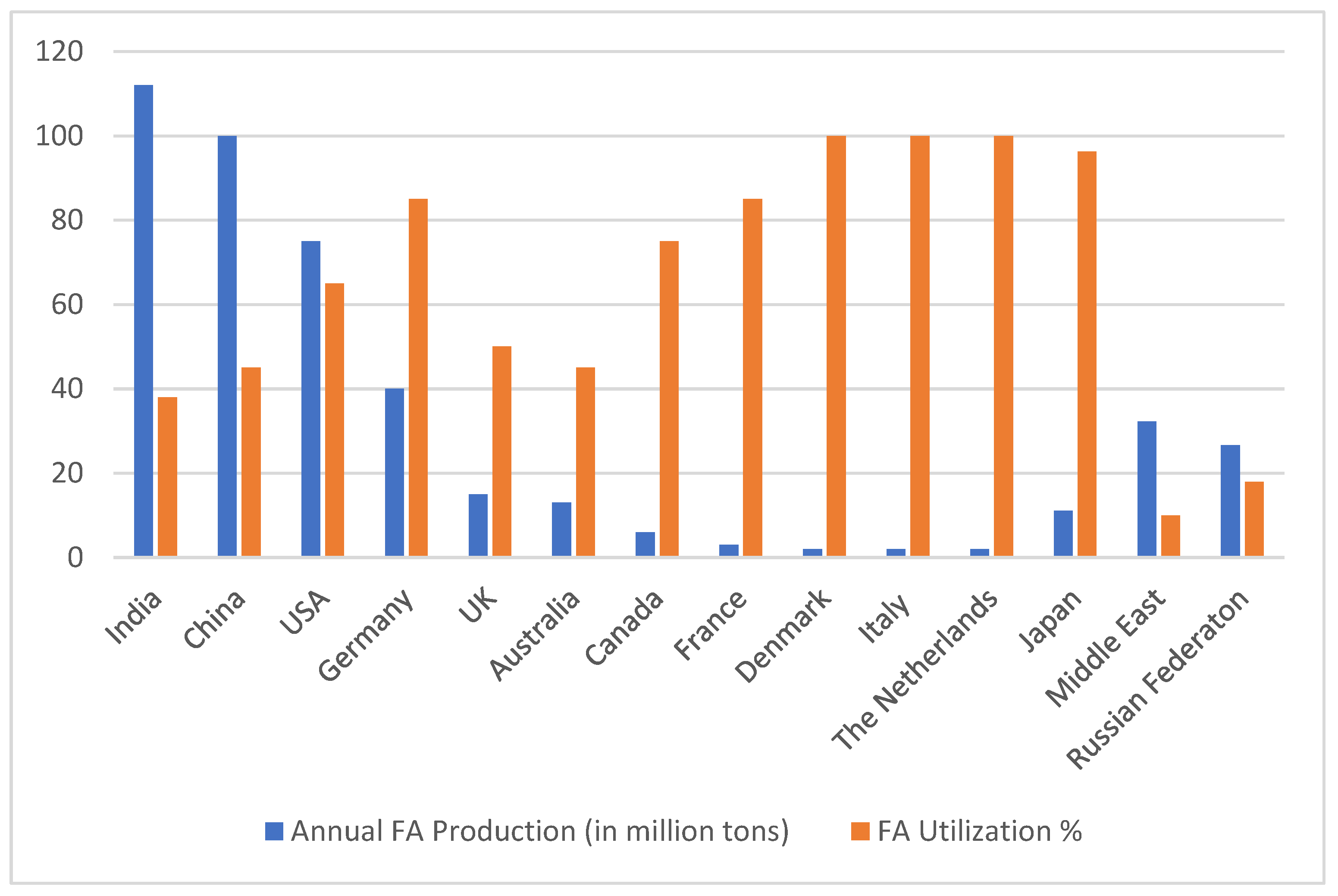
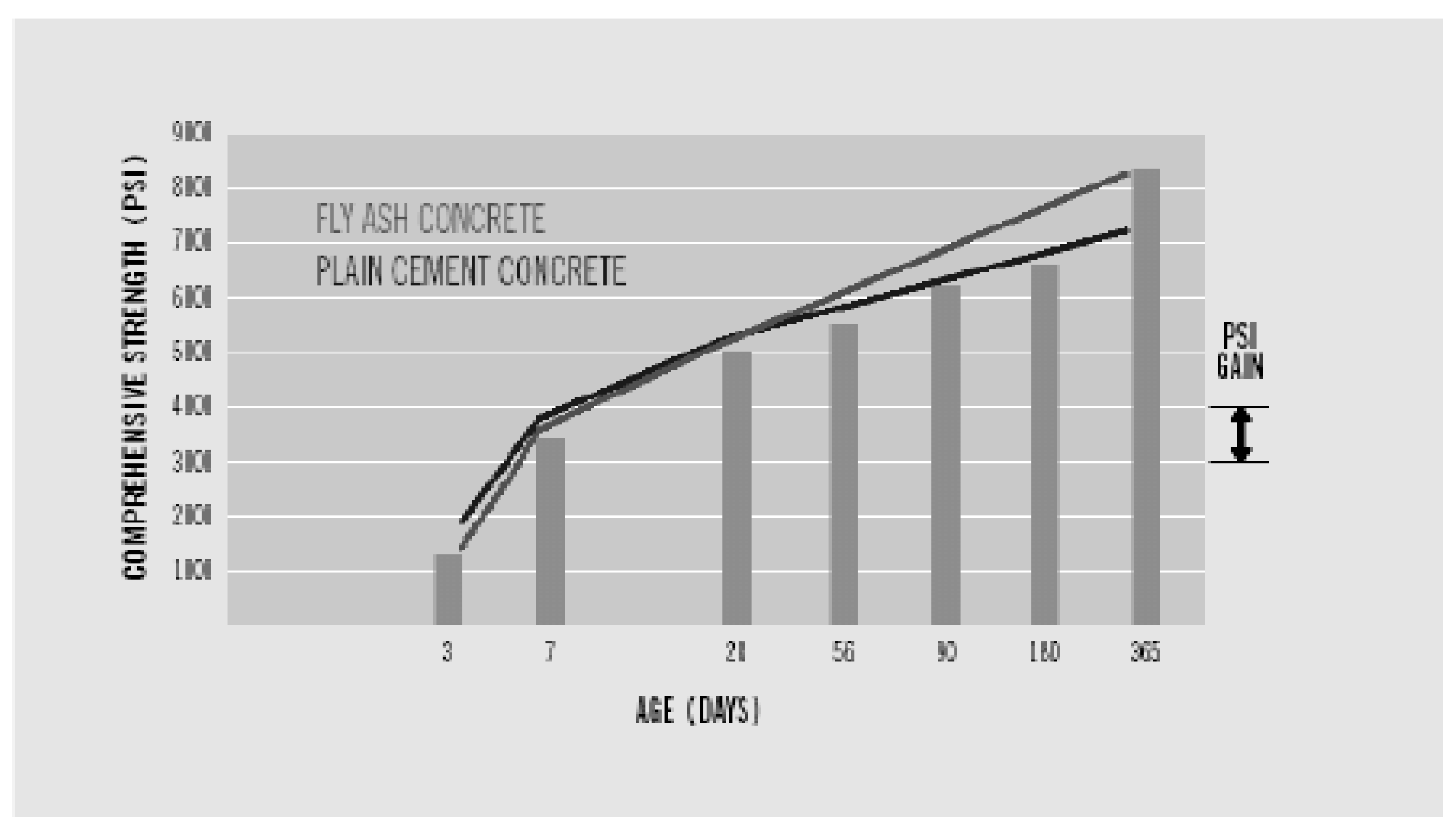
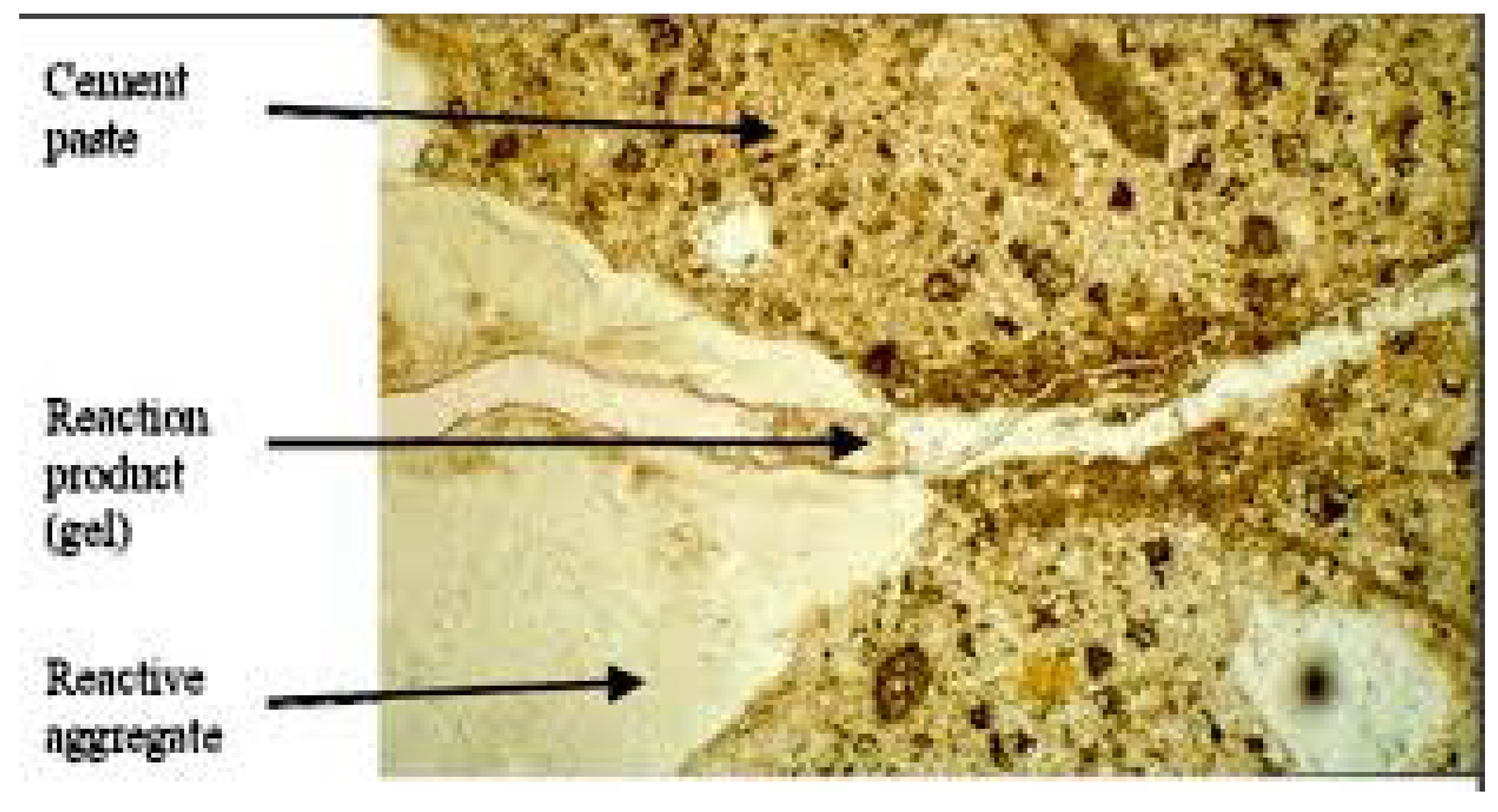
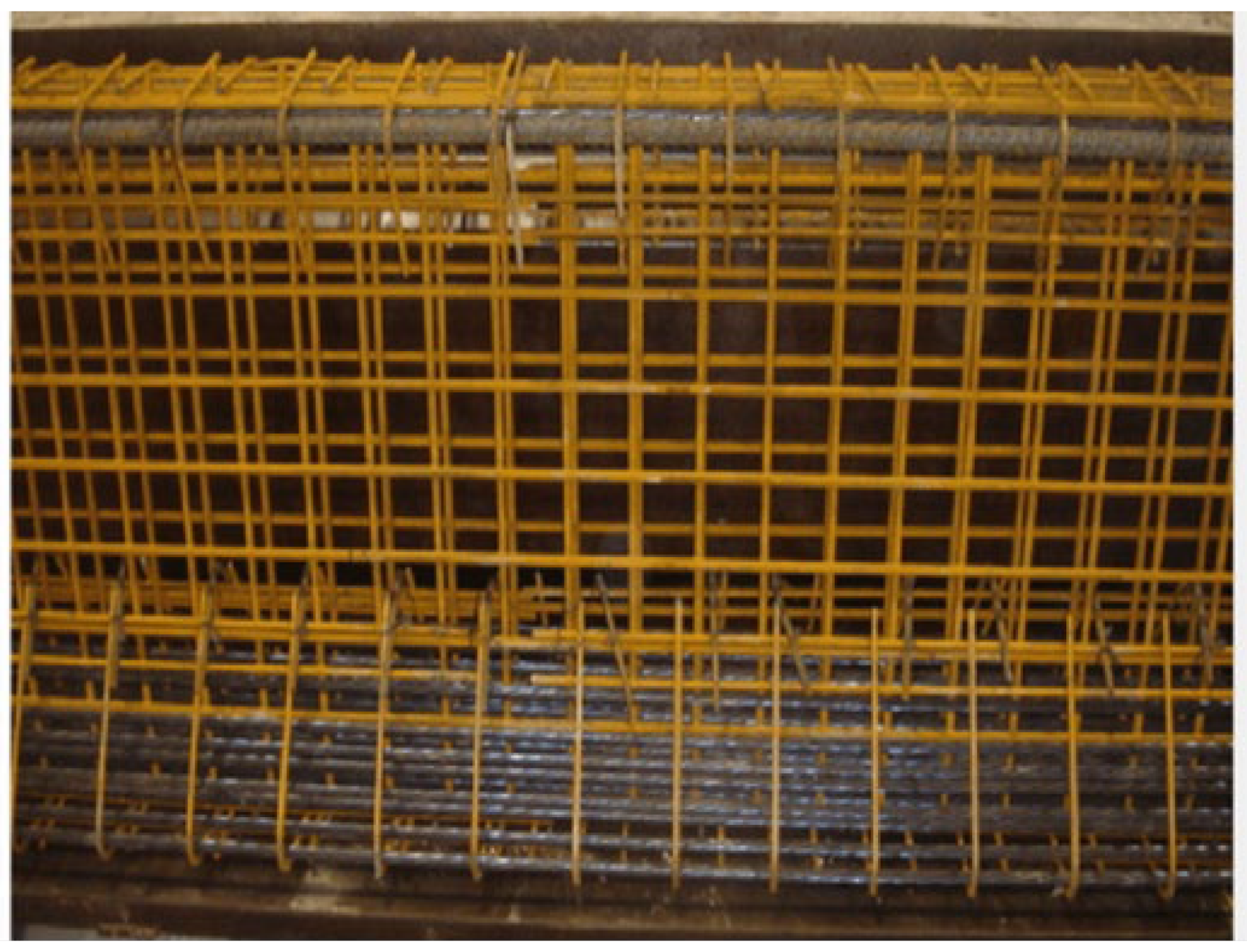
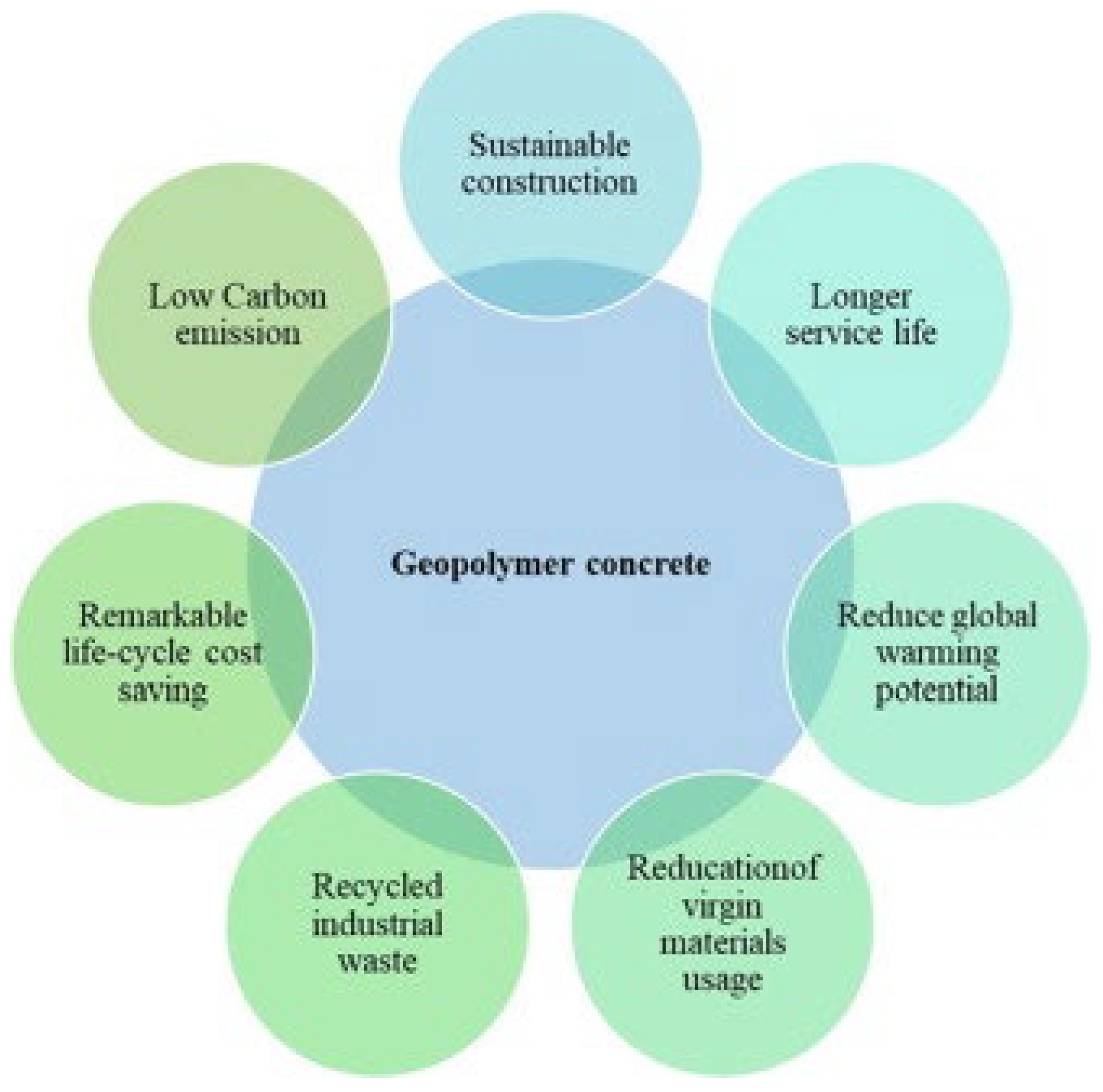
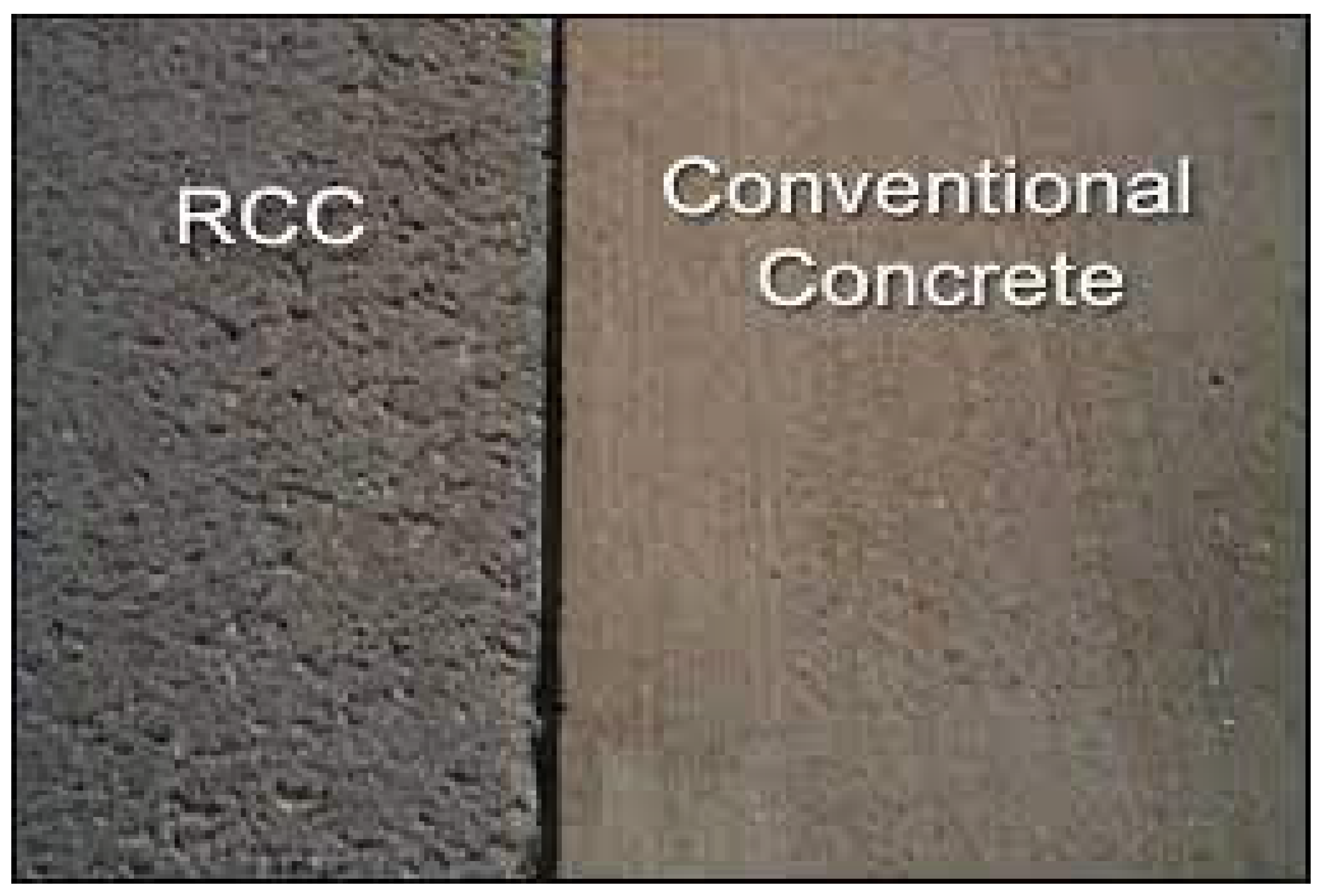
| Component | Bituminous | Subbituminous | Lignite |
|---|---|---|---|
| SiO2 | 20-60 | 40-60 | 15-45 |
| Al2O3 | 5-35 | 20-30 | 10-25 |
| Fe2O3 | 10-40 | 4-10 | 4-15 |
| CaO | 1-12 | 5-30 | 15-40 |
| MgO | 0-5 | 1-6 | 3-10 |
| SO3 | 0-4 | 0-2 | 0-10 |
| Na2O | 0-4 | 0-2 | 0-6 |
| K2O | 0-3 | 0-4 | 0-4 |
| LOI | 0-15 | 0-3 | 0-5 |
| Percentage | Class F | Class C | ||
|---|---|---|---|---|
| Chemical Requirements | SiO2+Al2O3+Fe2O3 | Min % | 70 | 50 |
| SiO3 | Max % | 5 | 5 | |
| Moisture Content | Max % | 3 | 3 | |
| Loss on Ignition | Max % | 5 | 5 | |
| Optional Chemical Requirement | Available alkalis | Max % | 1.5 | 1.5 |
| Physical Requirements | Fineness (+325 Mesh) | Max % | 34 | 34 |
| Pozzolanic Activity/Cement (7 days) | Min % | 75 | 75 | |
| Water requirement | Max % | 105 | 105 | |
| Autoclave expansion | Max % | 0.8 | 0.8 | |
| Optional Physical Requirements | Multiple factor (LOI x fineness) | 255 | - | |
| Increase in drying shrinkage | Max % | 0.03 | 0.03 | |
| Uniformity requirement (air entraining agent) | Max % | 20 | 20 | |
| Cement-alkali reaction (mortar expansion) | Max % | 0.02 | - |
| Property | Fly Ash Effect on Concrete | Technical Specifications/Testing |
| Workability [53,54,55,56] | Improved by using fly ash, measured by concrete slump and SCC spread diameter | ASTM C143, ASTM C1611, ASTM C1621, ASTM C1610 |
| Pumpability [57] | Better pumpability due to improved workability and delayed set time | ACI 211.9R-18 |
| Set Time [58] | Set time is extended when fly ash is used. Specially with high carbon fly ash (Fly ash class F results in more set time delay as compared to class C) | ASTM C403/C403-M |
| Early Strength [59] | Class F fly ash tends to delay early strength gain. Class C fly ash tends to expedite strength gain due to its self-cementing properties | ASTM C918M-20 |
| Long Term Strength [60] | Class C and F fly ash results in a long-term strength increase. The increase in long term strength is proportional to the amount of fly ash incorporated. This is validated by testing strength at 56 days | ASTM C39/C39M-15a |
| Permeability and Chloride Resistance [61,62] | Class C and F fly ash results in improved packing order for the granular constituents of concrete mix. Thus, permeability is reduced, and chloride resistance is improved | ASTM C1202-22e1, ACI PRC-228.2-13 |
| Alkali-Silica Reactivity [63,64] | Fly ash reduction to mix permeability results in decreased moisture ingress. Thus, ASR is mitigated. The incorporation of 30% of fly ash terminates ASR | ASTM C1567-21, ASTM C1293-08b |
Disclaimer/Publisher’s Note: The statements, opinions and data contained in all publications are solely those of the individual author(s) and contributor(s) and not of MDPI and/or the editor(s). MDPI and/or the editor(s) disclaim responsibility for any injury to people or property resulting from any ideas, methods, instructions or products referred to in the content. |
© 2023 by the authors. Licensee MDPI, Basel, Switzerland. This article is an open access article distributed under the terms and conditions of the Creative Commons Attribution (CC BY) license (http://creativecommons.org/licenses/by/4.0/).




